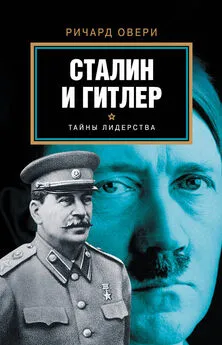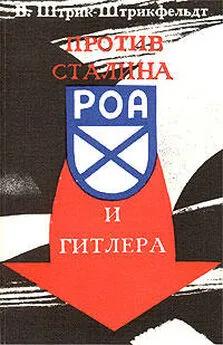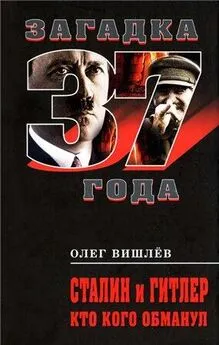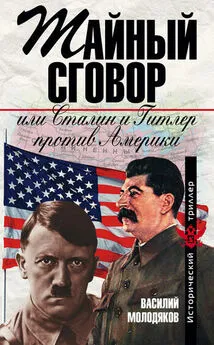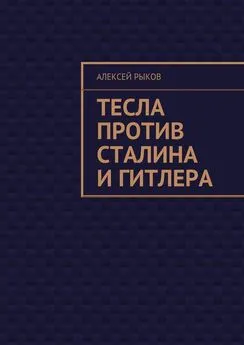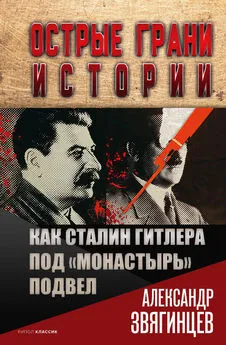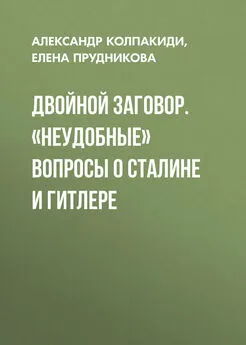Ричард Овери - Сталин и Гитлер
- Название:Сталин и Гитлер
- Автор:
- Жанр:
- Издательство:АСТ
- Год:2015
- Город:Москва
- ISBN:978-5-17-082961-3
- Рейтинг:
- Избранное:Добавить в избранное
-
Отзывы:
-
Ваша оценка:
Ричард Овери - Сталин и Гитлер краткое содержание
Что это были за личности?
Какими были методы их правления?
В чем мораль диктатуры как таковой и к чему она ведет?
На эти и другие наболевшие вопросы отвечает известный британский историк, автор крупных работ по истории Второй мировой войны Ричард Овери.
При сравнение и сопоставление двух режимов Овери рассматривает степень и характер народной поддержки, очаги противостояния и сопротивления, путь к власти каждого из диктаторов и процесс формирования культа личности и т. д.
Сталин и Гитлер - читать онлайн бесплатно полную версию (весь текст целиком)
Интервал:
Закладка:
123. Viola, Peasant Rebels, pp. 171–2.
124. Davies, Harrison and Wheatcroft, Economic Transformation, p. 68.
125. R. W. Davies, O. V. Khlevniuk, E. A. Rees, L. P. Kosheleva and L. A. Rogovaya (eds) The Stalin-Kaganovich Correspondence
1931–1936 (New Haven, Conn. 2003) pp. 180–81, letter from Stalin to Kaganovich, 11 August 1932. On the famine see S. G. Wheatcroft ‘More Light on the Scale of Repression and Excess Mortality in the Soviet Union in the 1930s’ in J. A. Getty and R. Manning (eds) Stalinist Terror: New Perspectives (Cambridge, 1993) pp. 278–89. Extrapolations from the demographic data suggest excess mortality of 4–5 million in total attributable to famine and its effects.
126. J. Rossman ‘A Workers’ Strike in Stalin’s Russia’ in Viola (ed.), Contending with Stalinism, pp. 45–6; J. Haslam ‘Political Opposition to Stalin and the Origins of the Terror in Russia, 1932–1936’, The Historical Journal, 29 (1986), pp. 396–9; B. Starkov ‘Trotsky and Ryutin: from the history of the anti-Stalin resistance in the 1930s’ in T. Brotherstone and P. Dukes (eds) The Trotsky Reappraisal (Edinburgh, 1992), pp. 71–3.
127. Kuromiya, Stalin’s Industrial Revolution, p. 21.
128. R. G. Suny ‘Stalin and his Stalinism’, in I. Kershaw and M. Lewin (eds) Stalinism and Nazism: Dictatorships in Comparison (Cambridge, 1997), pp. 46–7.
129. Lewin, Russian Peasants, p. 448.
130. R. Gaucher Opposition in the USSR, 1917–1967 (New York, 1969), p. 270.
131. The standard work is H. James The German Slump: Politics and Economics 1924–1936 (Oxford, 1986); see too J. von Krüdener (ed.) Economic Crisis and Political Collapse: the Weimar Republic 1924–1933 (Oxford, 1990).
132. S. Haffner Defying Hitler: a Memoir (London, 2002), p. 68.
133. D. Schumann Politisches Gewalt in der Weimarer Republik 1919–1933 (Essen, 2000), pp. 320, 335–7.
134. Zitelmann, Hitler, pp. 33–53, 62–75. ‘Our Party,’ Hitler announced in a speech in 1920, ‘must have a revolutionary character’; or in 1921, The salvation of Germany can only come… through revolution’ (p. 62).
135. T. Abel Why Hitler Came into Power: an Answer Based on the Original Life Stories of Six Hundred of his Followers (New York, 1938), p. 93.
136. Haffner, Defying Hitler, p. 71.
137. Stachura, Strasser, p. 76.
138. See P. Fritzsche Germans into Nazis (Cambridge, Mass., 1998), pp. 209ff. In general see C. Fischer The Rise of the Nazis (Manchester, 2002); M. Broszat Hitler and the Collapse of Weimar Germany (Leamington Spa, 1987); H. A. Turner Hitler’s Thirty Days to Power: January 1933 (London, 1996).
139. Avtorkhanov, Stalin and the Communist Party, pp. 1–2.
140. J. Biesemann Das Ermächtigungsgesetz als Grundlage der Gesetzgebung im nationalsozialistischen Staat (Münster, 1985), pp. 279–82.
141. Stalin, Works, vol. xiii, p. 354.
142. Volkogonov, Stalin: Triumph and Tragedy, p. 198.
143. J. Toland Adolf Hitler (New York, 1976), p. 361; H. Burden The Nuremberg Party Rallies: 1923–39 (London, 1967), pp. 76, 80–81.
144. Longerich, Die braunen Bataillone, p. 184. By mid-1934 the SA numbered 4.5 million. On the background see K. Heiden The Führer (New York, 1944), pp. 570–82; Kershaw, Hitler: Hubris, pp. 500–507.
145. Kershaw, Hitler: Hubris, p. 517.
146. Details in H.-G. Seraphim (ed.) Das politische Tagebuch Alfred Roenbergs aus den Jahren 1934/35 und 1939/40 (Göttingen, 1956), pp. 33–5.
147. M. Domarus Hitler: Reden und Proklamationen 1932–1945: Band I Triumph (Munich, 1965), p. 405.
148. Domarus, Hitler: Reden, p. 406.
149. Domarus, Hitler: Reden, pp. 424–5.
150. A. Knight Who Killed Kirov? The Kremlin’s Greatest Mystery (New York, 1999), p. 115.
151. Knight, Who Killed Kirov? pp. 172–4; Volkogonov, Stalin: Triumph and Tragedy, p. 200.
152. Knight, Who Killed Kirov? pp. 169–70; Volkogonov, Stalin: Triumph and Tragedy, pp. 205–6.
153. Knight, Who Killed Kirov? p. 183.
154. Knight, Who Killed Kirov? pp. 197–8; Getty and Manning, Stalinist Terror, pp. 45–9; M. Lenoe ‘Did Stalin Kill Kirov and Does it Matter?’, Journal of Modern History, 74 (2002), pp. 352–80.
155. On the ‘Lex Kirov’ Volkogonov, Stalin: Triumph and Tragedy, p. 208.
156. V. M. Berezhkov At Stalin’s Side (New York, 1994), p. 10.
Глава 2
1. D. Beetham Max Weber and the Theory of Modern Politics (London, 1974), p. 236.
2. A. Avtorkhanov The Communist Party Apparatus (Chicago, 1966), p. 52.
3. V. Garros, N. Korenevskaya and T. Lahusen (eds) Intimacy and Terror: Soviet Diaries of the 1930s (New York, 1995), pp. 205–6, diary of Galina Shtange, 12 December 1937, p. 357, diary of Lyubov Shaporina, 12 December 1937.
4. Garros et al., Intimacy and Terror, p. 206.
5. Garros et al., Intimacy and Terror, p. 357.
6. S. Labin Stalin’s Russia (London, 1949), p. 34.
7. L. Siegelbaum and A. Sokolov (eds) Stalinism as a Way of Life (New Haven, Conn., 2000), pp. 159–63; K.Petrone Life Has Become More Joyous, Comrades: Celebrations in the Time of Stalin (Bloomington, Ind., 2000), p. 175.
8. S. Davies Popular Opinion in Stalin’s Russia: Terror, Propaganda and Dissent 1934–1941 (Cambridge, 1997), pp. 102–12.
9. Davies, Popular Opinion, p. 112.
10. P. Hubert Uniformierter Reichstag: Die Geschichte der Pseudo-Volksvertretung 1933–1945 (Düsseldorf, 1992), pp. 88, 265; R. Gellateley Backing Hitler: Consent and Coercion in Nazi Germany (Oxford, 2001), pp. 15–16.
11. Hubert, Uniformierter Reichstag, p. 281.
12. Hubert, Uniformierter Reichstag, pp. 249–51, 274; IWM, FO 645, Box 156, testimony of Albert Göring, 25 September 1945, for details on voting ‘no’.
13. Hubert, Uniformierter Reichstag, p. 237.
14. J. Stalin Problems of Leninism (Moscow, 1947), p. 557, ‘On the Draft Constitution of the U.S.S.R.’, speech of 25 November 1936.
15. Ibid.
16. H. von Kotze and H. Krausnick (eds) ‘Es spricht der Führer’: 7 exemplarische Hitler-Reden (Gütersloh, 1966), p. 142, speech by Hitler to party district leaders, 29 April 1937.
17. Stalin, Problems, pp. 550–51; see too G. B. Carson Electoral Practices in the USSR (New York, 1955), pp. 50–52.
18. Hubert, Uniformierter Reichstag, pp. 61, 87; Kotze and Krausnick, ‘Es spricht der Führer’, p. 120.
19. Kotze and Krausnick, ‘Es spricht der Führer’, p. 140.
20. G. Neesse Die NSDAP: Versuch einer Rechtsdeutung (Stuttgart, 1935), pp. 143–5; Hubert, Uniformierter Reichstag, p. 240.
21. H. Rauschning Hitler Speaks (London, 1939), p. 199. Hitler told Rauschning that ‘there is no such thing as unlimited power… Even the most extreme autocrat is compelled to correct his absolute will by existing conditions.’
22. A. L. Unger Constitutional Development in the USSR: a Guide to Soviet Constitutions (London, 1981), pp. 50–52, 59–72.
23. The Constitution of the USSR. (Moscow, 1937), pp. 7–9.
24. Hubert, Uniformierter Reichstag, pp. 59–61; J. Biesemann Das Ermächtigungsgesetz als Grundlage der Gesetzgebung im nationalsozialistischen Staat (Münster, 1985), pp. 51–4, 381–2. On Hitler’s ideas of an advisory senate, Mein Kampf, vol. ii, pp. 501–2.
25. Hubert, Uniformierter Reichstag, pp. 58–63; M. Domarus (ed.) Hitler: Reden und Proklamationen 1932–1945: Band I, Triumph (Munich, 1965), p. 429; M. Moll (ed.) ‘Führer-Erlasse’, 1939–1945 (Stuttgart, 1997), pp. 49–50.
26. Labin, Stalin’s Russia, p. 31.
27. E. Lyons Assignment in Utopia (London, 1937).
28. E. van Ree The Political Thought of Joseph Stalin (London, 2002), pp. 148–9; see too J. Stalin Works (13 vols, Moscow, 1953–
55), vol. i., pp. 371–2 for his early views in ‘Anarchism or Socialism’, December 1906/January 1907. He distinguished two kinds of dictatorship – of the majority, ‘dictatorship of the street, of the masses, a dictatorship directed against all oppressors’, and a dictatorship of a minority or clique, which ‘tightens the noose around the neck of the majority’.
29. E. Mawdsley and S. White The Soviet Elite from Lenin to Gorbachev: The Central Committee and its Members 1917–1991 (Oxford, 2000), pp. 126–7; D. Volkogonov Stalin: Triumph and Tragedy (London, 1991), p. 217.
30. M. David-Fox and D. Hoffmann ‘The Politburo Protocols 1919–40’, Russian Review, 55 (1996), pp. 99–100; I. Pavlova The Strength and Weakness of Stalin’s Power’, in N. Rosenfeldt, B. Jensen and E. Kulavig (eds) Mechanisms of Power in the Soviet Union (London, 2000), p. 30; O. V. Khlevniuk Politburo – mekhanizmy politicheskoi vlasti v 1930-e gody (Moscow, 1996), pp. 330–31.
31. Mawdsley and White, Soviet Elite, p. 126; Khlevniuk, Politburo, pp. 288, 332–3; J. Löwenhardt, J. Ozinga and E. van Ree The Rise and Fall of the Soviet Politburo (London, 1992), pp. 34–5.
32. Khlevniuk, Politburo, pp. 246–52.
33. See, for example, the effects of a long Stalin holiday, from 30 June to 31 October 1935, in R. W. Davies, O. V. Khlevniuk, E. A. Rees, P. K. Liudmila and A. R. Larisa (eds) The Stalin – Kaganovich Correspondence 1931–1936 (New Haven, Conn., 2003), pp. 209–35.
34. T. J. Colton Moscow: Governing the Socialist Metropolis (Cambridge, Mass., 1995), p. 324–5, for Stalin’s close attention to the rebuilding of Moscow.
35. Khlevniuk, Politburo, pp. 290–91; see too M. Djilas Conversations with Stalin (New York, 1962), pp. 76–7: ‘It was at these dinners that the destiny of the vast Russian land, of the newly acquired territories, and, to a considerable degree, of the human race was decided.’ Djilas concluded, ‘At these dinners the Soviet leaders were at their closest, most intimate with each other.’
36. N. Rosenfeldt ‘“The Consistory of the Communist Church”: The Origins and Development of Stalin’s Secret Chancellery’, Russian History, 9 (1982), pp. 308–15, 318; N. Rosenfeldt, The Importance of the Secret Apparatus of the Soviet Communist Party during the Stalin Era’, in Rosenfeldt, Jensen and Kulavig, Mechanisms of Power, pp. 40–59; Pavlova, ‘Strengths and Weaknesses’, pp. 29–36. On Stalin’s regular access to secret intelligence on states abroad see V. V. Poznyakov ‘The Soviet Intelligence Services and the Government: Information and Military-Political Decisions from the early 1920s to the early 1950s’, in Rosenfeldt, Jensen and Kulavig, Mechanisms of Power, p. 107.
37. Rosenfeldt, ‘The Consistory of the Communist Church’, pp. 315–17, 321.
38. S. S. Montefi ore Stalin: the Court of the Red Tsar (London, 2003), pp. 59–60.
39. A. Knight Beria: Stalin’s First Lieutenant (London, 1993), pp. 172–3; Montefi ore, Court of the Red Tsar, p. 559.
40. Rosenfeldt, ‘The Consistory of the Communist Church’, pp. 320–23.
41. V. Serge The Case of Comrade Tulayev (London, 1968), pp. 257–8. See too V. Serge Memoirs of a Revolutionary 1901–1941 (Oxford, 1967), pp. 284 ff.
42. Kotze and Krausnick, ‘Es spricht der Führer’, p. 117.
43. J. Öhquist Das Reich des Führers (Bonn, 1943), p. 157.
44. H. Brausse Die Führungsordnung des deutschen Volkes: Grundlegung einer Führungslehre (Hamburg, 1940), pp. 54–60; Neesse, Die NSDAP, pp. 145–7: The Führer is the living embodiment of the majority of the people.’
45. Hubert, Uniformierter Reichstag, pp. 132–7.
46. Moll, Führer Erlasse, pp. 48–9; E. H. Schwaab Hitler’s Mind: a Plunge into Madness (New York, 1992), p. 43 cites Hans Frank: ‘In the formulation of the law, the historical will of the Führer is implemented, and the fulfi lment of this historical will of the Führer is not contingent on any prerequisites of the laws of the state.’
Читать дальшеИнтервал:
Закладка:
